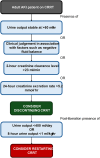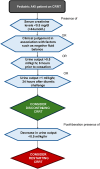Liberation from continuous renal replacement therapy due to renal recovery in adults and children: a literature review and Delphi consensus on clinical practice
- PMID: 40629374
- PMCID: PMC12239311
- DOI: 10.1186/s13054-025-05517-1
Liberation from continuous renal replacement therapy due to renal recovery in adults and children: a literature review and Delphi consensus on clinical practice
Abstract
Background: There is no current consensus on the appropriate timing for discontinuing continuous renal replacement therapy (CRRT). We aimed to review the current clinical evidence associated with the successful liberation from CRRT in patients with acute kidney injury and present a literature review with clinical practice points using a modified Delphi process.
Methods: EMBASE, CINAHL, PubMed, and CENTRAL libraries were searched for literature related to CRRT liberation in pediatric and adult AKI patients. A two-round modified Delphi process was conducted to establish clinical and research practice points for successful liberation from CRRT in adults and children. Statements with over 75% of respondents rating them at least a 3 on a 5-point Likert scale were classified as clinically relevant practice points. Statements requiring more data were labeled as future research recommendations.
Results: Out of 1,380 articles procured, 18 studies met the eligibility criteria: ten studies on adult CRRT liberation (n = 3,357 patients) and eight on pediatric CRRT liberation (n = 939 patients). Demographic, clinical, and laboratory information were abstracted from the medical records. Four pediatric and five adult studies mentioned urine output (UOP). In adults, a 2-hour creatinine clearance above 23 mL/min was found to be a strong predictor of successful CRRT liberation, with UOP thresholds of > 60 mL/hr or > 400 mL/day correlating with successful outcomes. In pediatric patients, UOP > 0.5 mL/kg/hr within 6 h before liberation appeared to be a reliable predictor. A pooled analysis was unable to be conducted due to the limited number of studies, variations in study design, significant heterogeneity of patient populations, absence of prospective and external validation, and the lack of a standardized definition for CRRT liberation.
Conclusions: UOP without the use of diuretics prior to liberation from CRRT was the most commonly reported predictor for successful CRRT liberation. In addition to urine output, urinary creatinine excretion, creatinine clearance, and fluid balance may be considered as potential predictive parameters when liberating from CRRT. Current recommendations emphasize the need for an individualized approach to CRRT liberation. Additional prospective studies are needed to strengthen these recommendations, focusing on the determination of UOP thresholds and validating additional clinical and biochemical parameters or risk-classification models.
© 2025. The Author(s).
Conflict of interest statement
Declarations. Ethics approval and consent to participate: Not applicable. Consent for publication: Not applicable. Competing interests: The authors declare no competing interests.
Figures


References
-
- Ronco C, Bellomo R, Kellum JA. Acute kidney injury. Lancet. 2019;394(10212):1949–64. - PubMed
-
- Hoste EAJ, Bagshaw SM, Bellomo R, Cely CM, Colman R, Cruz DN, et al. Epidemiology of acute kidney injury in critically ill patients: the multinational AKI-EPI study. Intensive Care Med. 2015;41(8):1411–23. - PubMed
-
- Vanholder R, Van Biesen W, Lameire N. What is the renal replacement method of first choice for intensive care patients? J Am Soc Nephrol. 2001;12(Suppl 17):S40–43. - PubMed
-
- The STARRT-AKI Investigators. Timing of initiation of Renal-Replacement therapy in acute kidney injury. N Engl J Med. 2020;383(3):240–51. - PubMed
-
- Zarbock A, Kellum JA, Schmidt C, Van Aken H, Wempe C, Pavenstädt H, et al. Effect of early vs delayed initiation of renal replacement therapy on mortality in critically ill patients with acute kidney injury: the ELAIN randomized clinical trial. JAMA. 2016;315(20):2190. - PubMed
Publication types
MeSH terms
LinkOut - more resources
Full Text Sources
Miscellaneous

